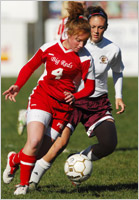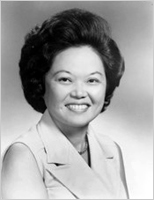EDUCATION | Driving tomorrow’s achievements
01 April 2008
U.S. Gender-Equity Law Led to Boom in Female Sports Participation
Research shows significant, lasting benefits from sports

Washington -- "No person in the United States shall, on the basis of sex be excluded from participation in, or denied the benefits of, or be subjected to discrimination under any educational program or activity receiving federal aid." -- Patsy T. Mink Equal Opportunity in Education Act
In 1972, with the exception of historically black colleges and universities, virtually no college offered women athletic scholarships. Athletics programming for women generally consisted of little other than cheerleading squads.
In U.S. secondary schools the situation was not much better: approximately 300,000 girls participated in sports, or roughly one in 27. They did not have the same access to coaches as boys, their athletic facilities were not of comparable quality and their competitive events and games were not given the same attention and resources.
Then, in 1972, landmark civil rights legislation was enacted that banned sex discrimination in U.S. schools, both in academic subjects and in athletics. Popularly known as “Title IX,” it was renamed the Patsy T. Mink Equal Opportunity in Education Act in 2002 after the death of the congresswoman from Hawaii who was its principal author.
Mink faced discrimination at the three universities she attended in the 1940s and 1950s and believed she was denied entrance to medical school because she was a woman. "I didn't start off wanting to be in politics," she once told a reporter. "I wanted to be a learned professional, serving the community. But they weren't hiring women just then. Not being able to get a job from anybody changed things."
When she became the first woman of color and first Asian-American woman elected to the U.S. House of Representatives in 1964, she championed the rights of immigrants, minorities, women and children. Title IX was her crowning legislative achievement, and its effect on women’s sports has been profound.
Today, almost 3 million girls participate in high school sports in the United States (roughly one in three).
According to most recent statistics (2005), National Collegiate Athletics Association (NCAA) Division I student bodies were, on average, 54 percent female, while athletic programs were 45 percent female, up from 31 percent in 1990, according to the NCAA and U.S. Education Department. Between 1971 and 2005, female participation in collegiate sports increased 456 percent.
Division I, the highest level of NCAA membership, requires schools to sponsor at least seven sports for men and seven for women (or six for men and eight for women) with two team sports for each gender.

U.S. schools are required to provide both sexes with equal opportunities for sports participation and equal numbers of athletics scholarships. They also have to treat male and female teams equally in terms of allocating resources, scheduling events, publicity and access to coaches.
While broadly popular with the U.S. public, Title IX has not been without controversy.
“Title IX has removed barriers to women's participation in sports. But it has also caused great damage, in part because it has led to the adoption of a destructive quota system,” writes Christina Hoff Sommers, a resident scholar at the American Enterprise Institute, a conservative-leaning policy research organization in Washington.
She says that schools that are unable to attract equal numbers of men and women to participate in sports often drop men’s teams to avoid government censure, funding cuts and lawsuits.
A recent report by the National Coalition for Women and Girls in Education found “stunning progress,” but also states that “much remains to be done, for the evidence shows that girls and women continue to suffer discrimination in many educational activities, although it is usually in a more subtle form than it was before Title IX was enacted.”
The report also maintains that, “contrary to the critics’ claims, boys’ and men’s opportunities to play sports have continuously increased since 1972, albeit at a slower rate than that of girls and women -- who had so few opportunities before Title IX.”
Participation in sports is far from a trivial issue. Research has shown the benefits of such participation are significant and long-lasting.
A study published in 2007, for example, showed that playing on a high school sports team increased a young woman’s chances of graduating from college by 41 percent.
“If the goal is for girls to get a higher education, our findings favor the idea of girls playing high school sports,” said Mikaela Dufur, a sociology professor at Brigham Young University in Utah and co-author of the research.
A study in 2002 showed that athletics help student academic performance in high school more than any other extracurricular activity. Decreased drug use, improved health, better grades, increased confidence and other benefits also have been found by various researchers.
The full text (PDF, 12 pages) of the report from the National Coalition for Women and Girls in Education is available on the group’s Web site.
